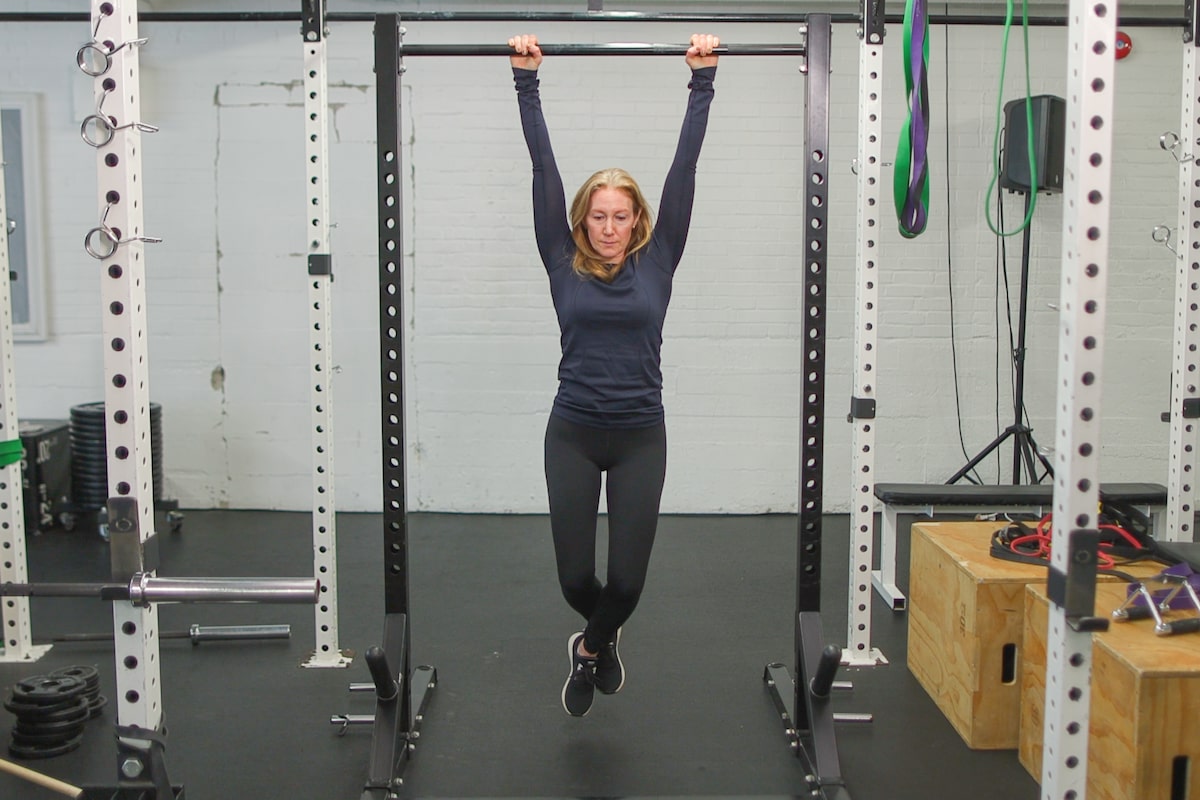Alyssa Ages performs a pull-up exercise at MOVE fitness club in Toronto.Nick Iwanyshyn/The Globe and Mail
They’re a cool party trick, a hallmark of any action-movie training montage and a requirement for entering the armed forces. But if none of those are part of your daily life or goals, do you really need to be able to do a pull-up?
The exercise move, in which you use your lats, traps and shoulders to pull your body up to an overhead bar, serves a greater purpose than just showing off.
Pulling is one of the fundamental human movement patterns we use on a daily basis – when picking up a package, opening the refrigerator or bringing an item down from a high shelf. Pull-ups help build the upper body strength and control needed to continue performing those basic tasks pain-free into older age. Training the primary pulling muscles can also improve posture. Sitting for long periods of time, especially at a desk, causes us to hunch our backs and pull our shoulders forward, but strengthening the muscles of the upper back helps you keep your shoulders pulled back while sitting or standing.
Grip strength, which has been shown to be a marker of health and longevity, can also be improved by doing pull-ups. Diminished grip strength is associated with all-cause and cardiovascular mortality as well as cognitive decline and dementia.
“Grip is important for everything we do, from picking things up off the ground to carrying groceries,” says Blair Lyon, owner of Toronto’s CrossFit YKV.” To prepare his athletes to do unassisted pull-ups, Lyon has a few go-to moves. Here’s how he recommends building your strength to add this powerhouse exercise to your workouts.
A 10-Week Pull-Up Program
The move seems simple on the surface: Grip an overhead bar with your palms facing toward you and pull your body up so your chin clears the top of the bar. But executing it correctly takes work.
Begin by warming up the back and shoulders with three sets of 15 internal and external rotations and three sets of 15 deltoid raises. Determine your working weight by starting light, then selecting a weight that feels like a seven out of 10 on a scale of effort. If you can’t complete the last rep, go lighter. If you feel like you could do a few more, add some weight.
Dead Hang
If you can’t reach an overhead bar from a standing position, place a box or bench underneath and begin by standing on top. Use an overhand grip (palms facing away from you) to grasp the bar, with your hands wider than shoulder-width. Step off the box, allowing your body to hang. Squeeze your glutes and quads and engage your core to keep your lower back from arching. The first time you do this, try to hang on for 20-30 seconds. As you get more comfortable, work up to four sets of 30-second holds with 45-60 seconds of rest in between.
Barbell Bent Over Row
You can perform this one with a barbell or a set of dumbbells. Hold the barbell with both hands (or a dumbbell in each hand) with your palms facing toward you and your hands slightly wider than shoulder width apart. Keeping a flat back, hinge at your hips until your torso is close to parallel with the floor. Engaging your lats, draw your elbows up and back, pulling your shoulder blades together until the bar touches your chest or your elbows reach your midline (if you’re using dumbbells). Pause at the top, then slowly return to the starting position. Do four sets of five reps with 60-90 seconds of rest between sets.
Lat Pull-Down
The most basic way to do this is using a lat pull-down machine. If you don’t have access to one, you can loop a lightweight resistance band over a pull-up bar. Place your palms face-down on the bottom loop of the band with your hands positioned shoulder-width apart and the bottom of the band at about chest height. Keeping your arms straight and your torso still, press down on the band and slowly lower it down toward your hips without bending your arms or compromising your form. Focus on drawing your shoulders back and down. Pause, then return to the starting position. Do four sets of six to eight reps with 60-90 seconds rest between sets.
Eccentric Pull-Ups
Place a box or bench under a pull-up bar, slightly behind the bar. Step onto the box and place your hands on the bar slightly wider than shoulder-width, with palms facing forward. Jump off the box and up, finishing at the top of a pull-up position with your chin over the bar. Pause, engage your core and squeeze your glutes, and slowly lower yourself down for a count of three to five seconds, until you reach a dead hang. Come down to the floor to complete the rep. Do four sets of five reps with 60 to 90 seconds rest between sets.
Band-Assisted Pull-Up
Loop a long elastic band over a pull-up bar. The heavier the weight of the band, the easier the pull-up will feel. Place a box or bench under a pull-up bar, slightly behind the bar. Step onto the box, then reach up, grab the bottom loop of the band, and place it under the arch of one foot. Place your hands on the bar slightly wider than shoulder-width, with palms facing forward. Step off the box into a dead hang and cross your free ankle over the one supported by the band. Engage your core, squeeze your glutes and pull down on the bar, imagining you’re trying to pull it into your chest. Keep pulling until your chin is above the bar. Pause, then slowly return to the dead hang before starting the next rep. Do four sets of five reps with 60 to 90 seconds rest between sets.
Alyssa Ages is a journalist and the author of Secrets of Giants: A Journey to Uncover the True Meaning of Strength. She is also a strongman competitor and endurance athlete, as well as a former personal trainer and group fitness instructor.
Watch for the Globe’s workout guides throughout the summer, which will focus on protecting and strengthening common pain points, from the hips to knees.




